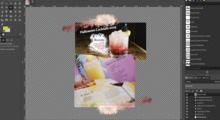A sequence of actions
This discussion is connected to the gimp-user-list.gnome.org mailing list which is provided by the GIMP developers and not related to gimpusers.com.
This is a read-only list on gimpusers.com so this discussion thread is read-only, too.
| A sequence of actions | Tarun Samvedi | 30 Mar 19:01 |
| A sequence of actions | Michael J. Hammel | 30 Mar 19:22 |
| A sequence of actions | Jay Smith | 30 Mar 20:07 |
| A sequence of actions | Tarun Samvedi | 30 Mar 20:17 |
| A sequence of actions | Rob Antonishen | 30 Mar 20:29 |
| A sequence of actions | photocomix | 02 Apr 00:26 |
| A sequence of actions | photocomix | 02 Apr 00:34 |
| A sequence of actions | David Hodson | 31 Mar 11:44 |
A sequence of actions
Is there any way of defining a sequence of actions that could be used later? for instance, if I apply auto-color, auto-contrast and cartoon filter to a lot of images, is there a way of defining this sequence so it can be done in a single step?
Tarun
A sequence of actions
On Tue, 2010-03-30 at 22:31 +0530, Tarun Samvedi wrote:
Is there any way of defining a sequence of actions that could be used later?
for instance, if I apply auto-color, auto-contrast and cartoon filter to a lot of images, is there a way of defining this sequence so it can be done in a single step?
Current version does not support recording actions directly. Instead you need to write a plugin using one of the supported languages: Python, Script-Fu or C. For something simple like this python is probably the easiest to learn. For more complex plugins I write C plugins, but then I'm more comfortable with C than Python.
A sequence of actions
On 03/30/2010 01:22 PM, Michael J. Hammel wrote:
On Tue, 2010-03-30 at 22:31 +0530, Tarun Samvedi wrote:
Is there any way of defining a sequence of actions that could be used later?
for instance, if I apply auto-color, auto-contrast and cartoon filter to a lot of images, is there a way of defining this sequence so it can be done in a single step?Current version does not support recording actions directly. Instead you need to write a plugin using one of the supported languages: Python, Script-Fu or C. For something simple like this python is probably the easiest to learn. For more complex plugins I write C plugins, but then I'm more comfortable with C than Python.
I am glad that Tarun brought this up.
Question: Has somebody written a generic large script or set of scripts or "library" of script components that would allow an "ordinary user" with only the most basic programming skills to grab the bits they need for their particular "sequence of actions"? Something that a basic user could edit down to what they need or cut/paste out the bits they need?
I know one could study existing scripts and try to learn from them, but that is different than a script that is fully commented and designed for the purpose of taking the modular bits you need to build your own modular script.
IMHO, the lack of a "recording actions" function, is the weakest aspect of Gimp. Photoshop 5 had this (though it was somewhat limited) along with batch-running operations .... and that was released in May 1998, 12 years ago.
I appreciate that such a "recording actions" feature will become available when somebody steps up to create it. (And no, I do not have the skills to do so.)
I am sure that Sven will rip me a new one for saying so.... though I have the utmost respect for the folks that have the skills and time to do such programing, but I want to "use Gimp", not "learn a program language".
Jay
A sequence of actions
Michael, Jay - Thanks for the response :)
I'll be trying to implement the idea for GSoC, was just making sure there is no way of doing it which is unknown to me.
On Tue, Mar 30, 2010 at 11:37 PM, Jay Smith wrote:
On 03/30/2010 01:22 PM, Michael J. Hammel wrote:
On Tue, 2010-03-30 at 22:31 +0530, Tarun Samvedi wrote:
Is there any way of defining a sequence of actions that could be used later?
for instance, if I apply auto-color, auto-contrast and cartoon filter to a lot of images, is there a way of defining this sequence so it can be done in a single step?Current version does not support recording actions directly. Instead you need to write a plugin using one of the supported languages: Python, Script-Fu or C. For something simple like this python is probably the easiest to learn. For more complex plugins I write C plugins, but then I'm more comfortable with C than Python.
I am glad that Tarun brought this up.
Question: Has somebody written a generic large script or set of scripts or "library" of script components that would allow an "ordinary user" with only the most basic programming skills to grab the bits they need for their particular "sequence of actions"? Something that a basic user could edit down to what they need or cut/paste out the bits they need?
I know one could study existing scripts and try to learn from them, but that is different than a script that is fully commented and designed for the purpose of taking the modular bits you need to build your own modular script.
IMHO, the lack of a "recording actions" function, is the weakest aspect of Gimp. Photoshop 5 had this (though it was somewhat limited) along with batch-running operations .... and that was released in May 1998, 12 years ago.
I appreciate that such a "recording actions" feature will become available when somebody steps up to create it. (And no, I do not have the skills to do so.)
I am sure that Sven will rip me a new one for saying so.... though I have the utmost respect for the folks that have the skills and time to do such programing, but I want to "use Gimp", not "learn a program language".
Jay
A sequence of actions
Currently the "blocks" of steps that can be performed are all contained in the pdb.
There are two different ways to get the same result (a set of actions that can be repeated in a single "call")
1) tap into the history buffer somehow to "record" then "playback history" from a different point in history. THis would require modifications to the core, and may not be portable to a gegl model. 2) provide a gui/visual language front-end to the pdb (think inputs/outputs/connectors) to visually create scripts that either get turned into scheme in the back end, or get implemented directly. This could be done as a plugin that would allow creation, saving and loading actions.
-Rob A>
On Tue, Mar 30, 2010 at 2:17 PM, Tarun Samvedi wrote:
Michael, Jay - Thanks for the response :)
I'll be trying to implement the idea for GSoC, was just making sure there is no way of doing it which is unknown to me.
A sequence of actions
On Tue, 2010-03-30 at 14:07 -0400, Jay Smith wrote:
Question: Has somebody written a generic large script or set of scripts or "library" of script components that would allow an "ordinary user" with only the most basic programming skills to grab the bits they need for their particular "sequence of actions"? Something that a basic user could edit down to what they need or cut/paste out the bits they need?
Not quite what you were asking, but DBP is a plugin designed to provide the most common operations for batch processing (without scripting). It's limited in its operations (by design and lack of spare time), but many people find it useful.
-- David
- postings
- 65
A sequence of actions
Maybe the Mathmap plugin and specifically its "Composer" offer something close to your need
The composer, and the option to save the new "composite " filters are limited to the filter included in mathmap
That anyway are a lots ,much more are available on the net, all are editable and since is not just a plugin but also a framework to create new filter the limit is no so severe
Currently the "blocks" of steps that can be performed are all contained in the pdb.
There are two different ways to get the same result (a set of actions that can be repeated in a single "call")
1) tap into the history buffer somehow to "record" then "playback history" from a different point in history. THis would require modifications to the core, and may not be portable to a gegl model. 2) provide a gui/visual language front-end to the pdb (think inputs/outputs/connectors) to visually create scripts that either get turned into scheme in the back end, or get implemented directly. This could be done as a plugin that would allow creation, saving and loading actions.
-Rob A>
On Tue, Mar 30, 2010 at 2:17 PM, Tarun Samvedi wrote:
Michael, Jay - Thanks for the response :)
I'll be trying to implement the idea for GSoC, was just making sure there
is
no way of doing it which is unknown to me.
- postings
- 65
A sequence of actions
There are two different ways to get the same result (a set of actions that can be repeated in a single "call")
1) tap into the history buffer somehow to "record" then "playback history" from a different point in history. THis would require modifications to the core, and may not be portable to a gegl model.
I fear that is not possible
Because the Gimp History is not accessible for plugin or script ,and seems by
purpose
I have no clear the reason behind that "purpose" but if i remember well most of devs agreed that history should be not accessible (except by the user from the gui, but that i not relevant here
the point herewould be grant access to the history for a plugin, or more exactly to fetch data in a macro recorder











